Abstract
Considerable controversy exists over the purported role of obesity in causing hyperglycemia, hyperlipemia, hyperinsulinemia, and insulin resistance; and the potential beneficial effects of weight reduction remain incompletely defined. Hypertriglyceridemia is one of the metabolic abnormalities proposed to accompany obesity, and in order to help explain the mechanisms leading to this abnormality we have proposed the following sequential hypothesis: insulin resistance → hyperinsulinemia → accelerated hepatic triglyceride(TG) production → elevated plasma TG concentrations. To test this hypothesis and to gain insight into both the possible role of obesity in causing the above metabolic abnormalities and the potential benefit of weight reduction we studied the effects of weight loss on various aspects of carbohydrate and lipid metabolism in a group of 36 normal and hyperlipoproteinemic subjects. Only weak to absent correlations (r = 0.03 — 0.46) were noted between obesity and the metabolic variables measured. This points out that in our study group obesity cannot be the sole, or even the major, cause of these abnormalities in the first place. Further, we have observed marked decreases after weight reduction in fasting plasma TG (mean value: pre-weight reduction, 319 mg/100 ml; post-weight reduction, 180 mg/100 ml) and cholesterol (mean values: pre-weight reduction, 282 mg/100 ml; post-weight reduction, 223 mg/100 ml) levels, with a direct relationship between the magnitude of the fall in plasma lipid values and the height of the initial plasma TG level. We have also noted significant decreases after weight reduction in the insulin and glucose responses during the oral glucose tolerance test (37% decrease and 12% decrease, respectively). Insulin and glucose responses to liquid food before and after weight reduction were also measured and the overall post-weight reduction decrease in insulin response was 48% while the glucose response was relatively unchanged. In a subgroup of patients we studied both the degree of cellular insulin resistance and the rate of hepatic very low density (VLDL) TG production before and after weight reduction. These subjects demonstrated significant decreases after weight reduction in both degree of insulin resistance (33% decrease) and VLDL-TG production rates (40% decrease). Thus, weight reduction has lowered each of the antecedent variables (insulin resistance, hyperinsulinemia, and VLDL-TG production) that according to the above hypothesis lead to hypertriglyceridemia, and we believe the overall scheme is greatly strengthened. Furthermore, the consistent decreases in plasma TG and cholesterol levels seen in all subjects lead us to conclude that weight reduction is an important therapeutic modality for patients with endogenous hypertriglyceridemia.
Full text
PDF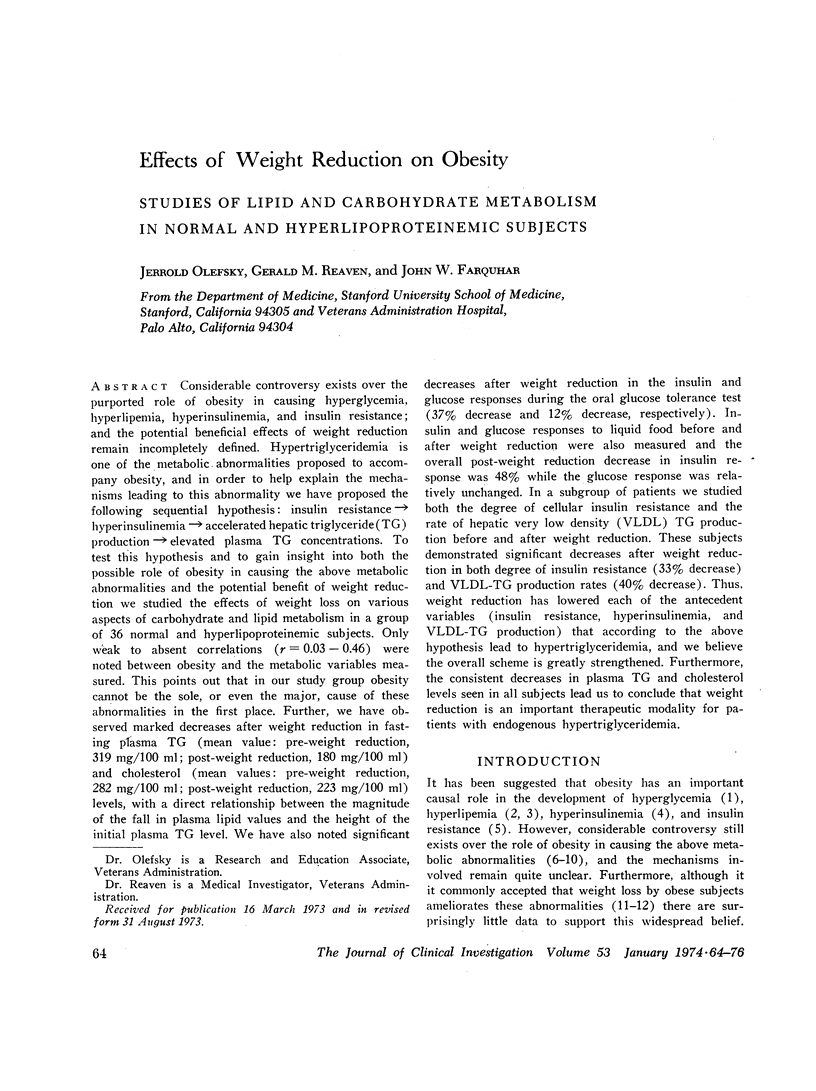
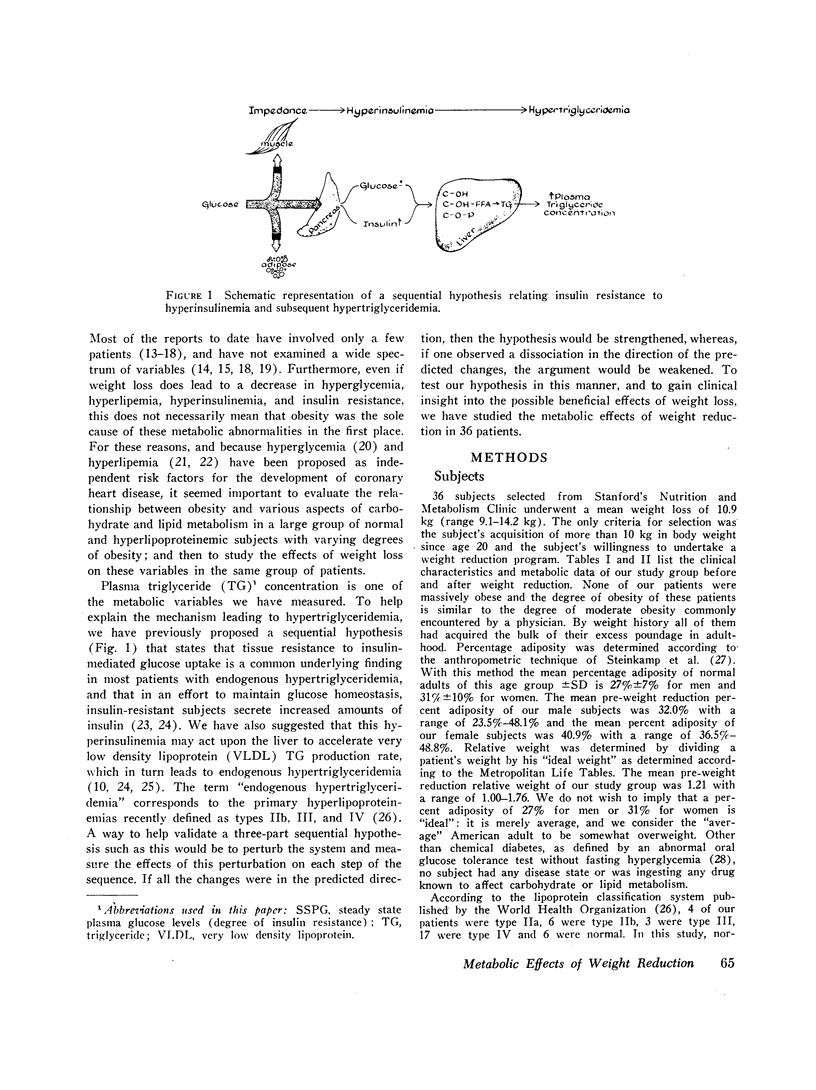
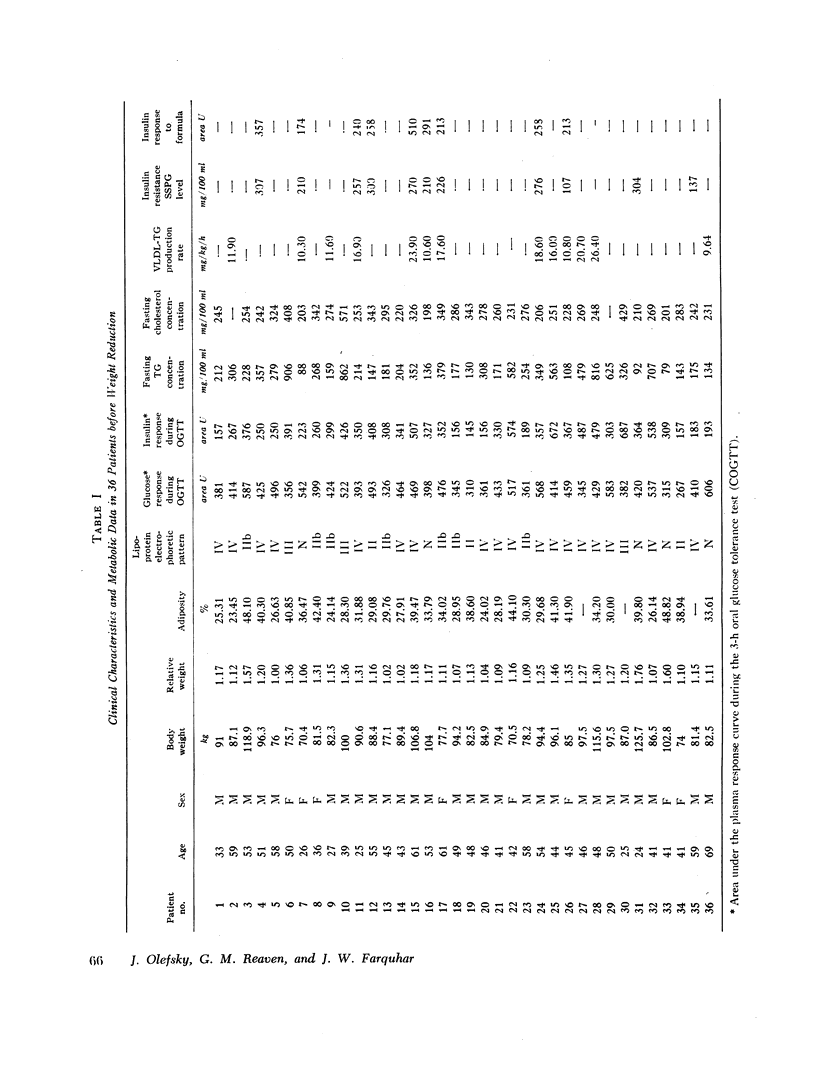
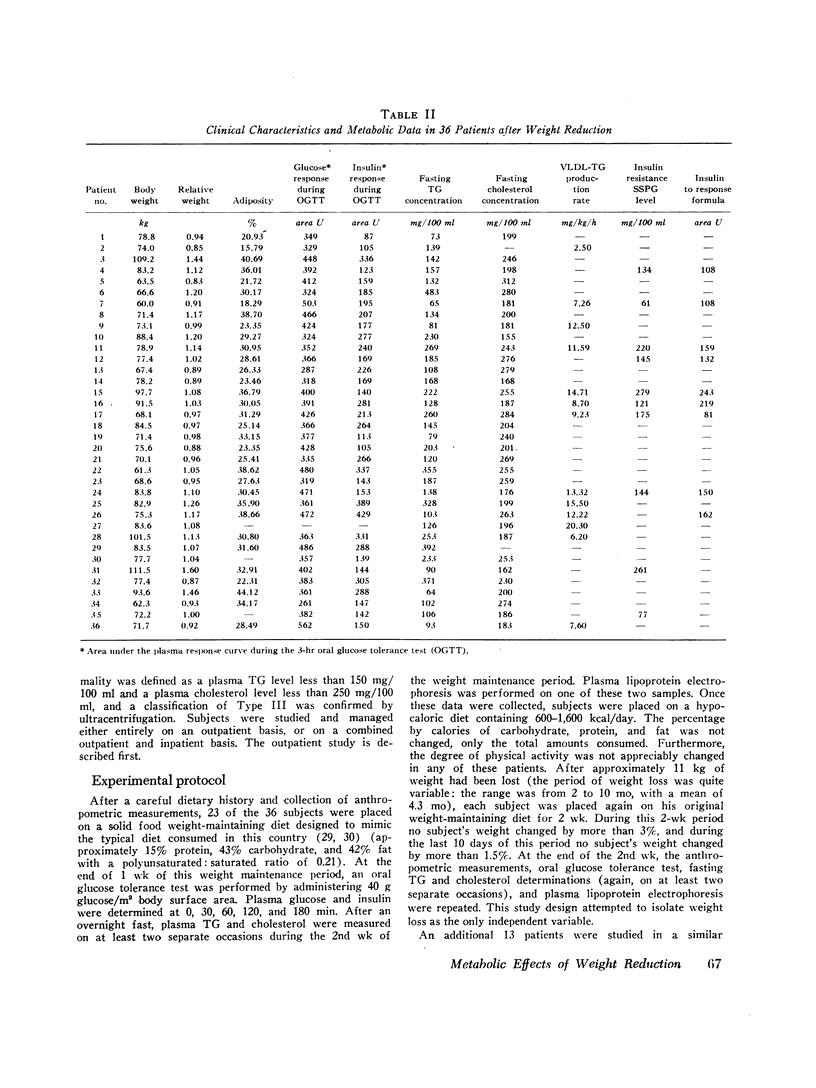
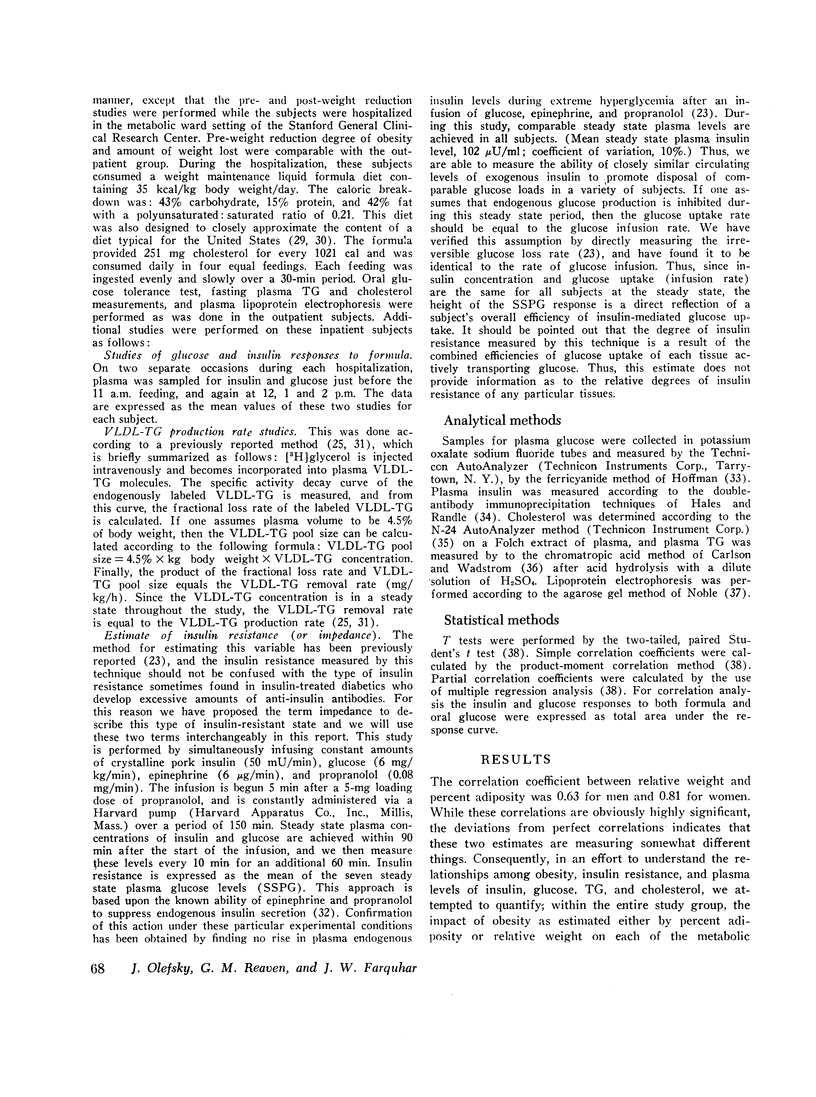
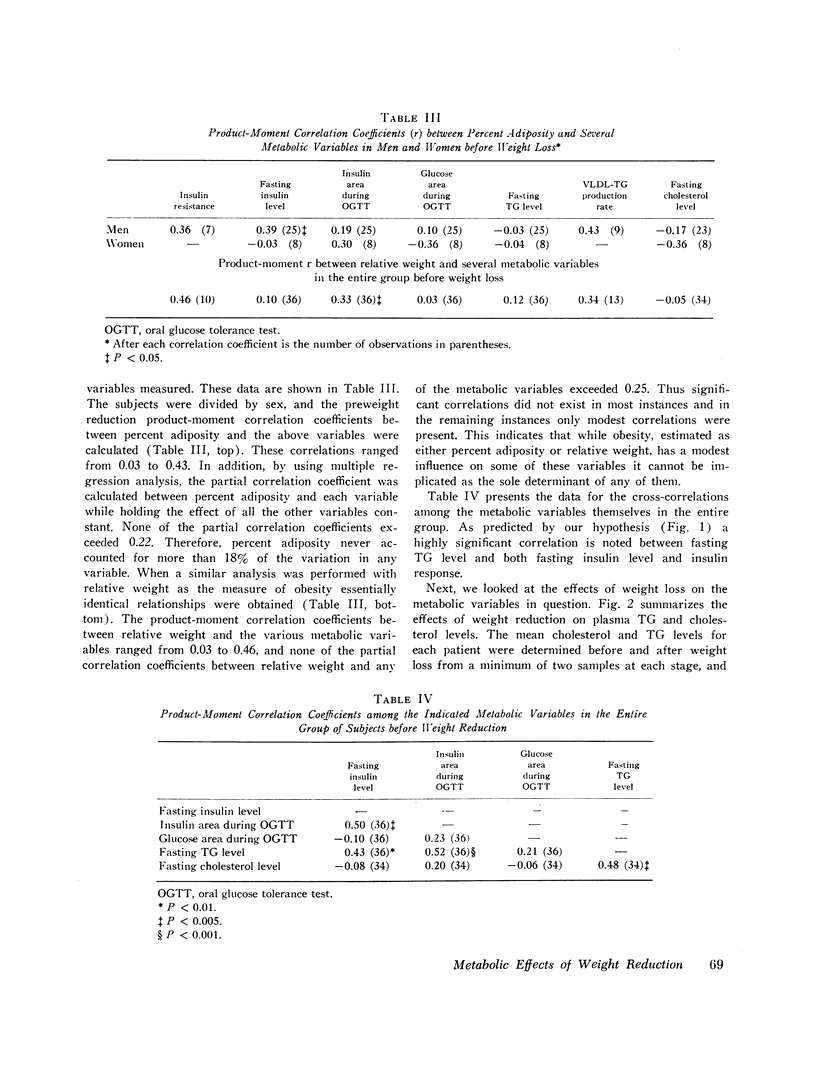
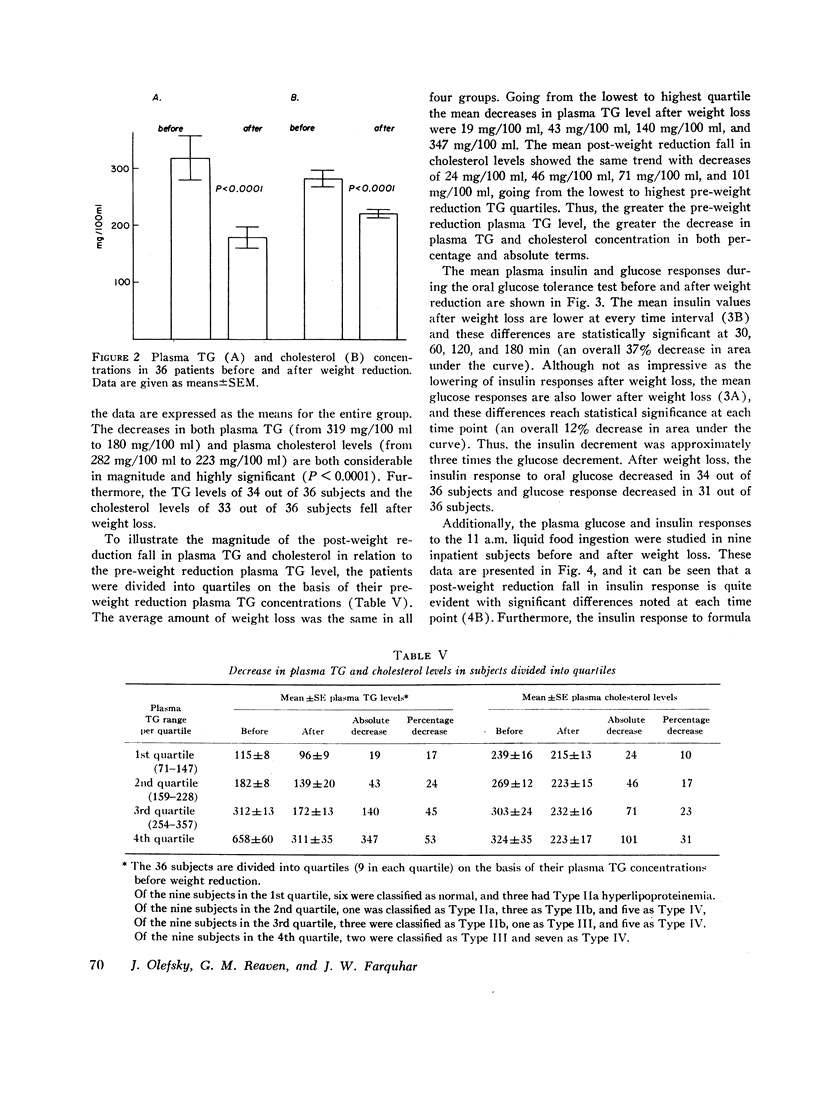
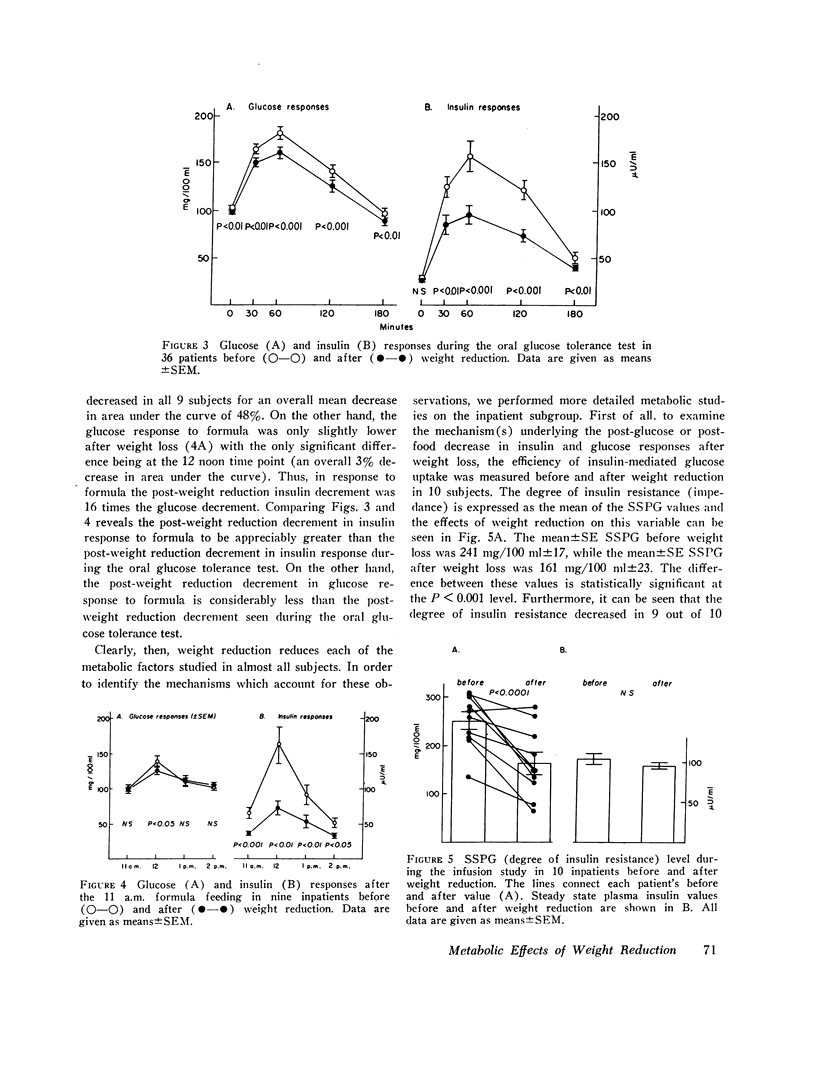
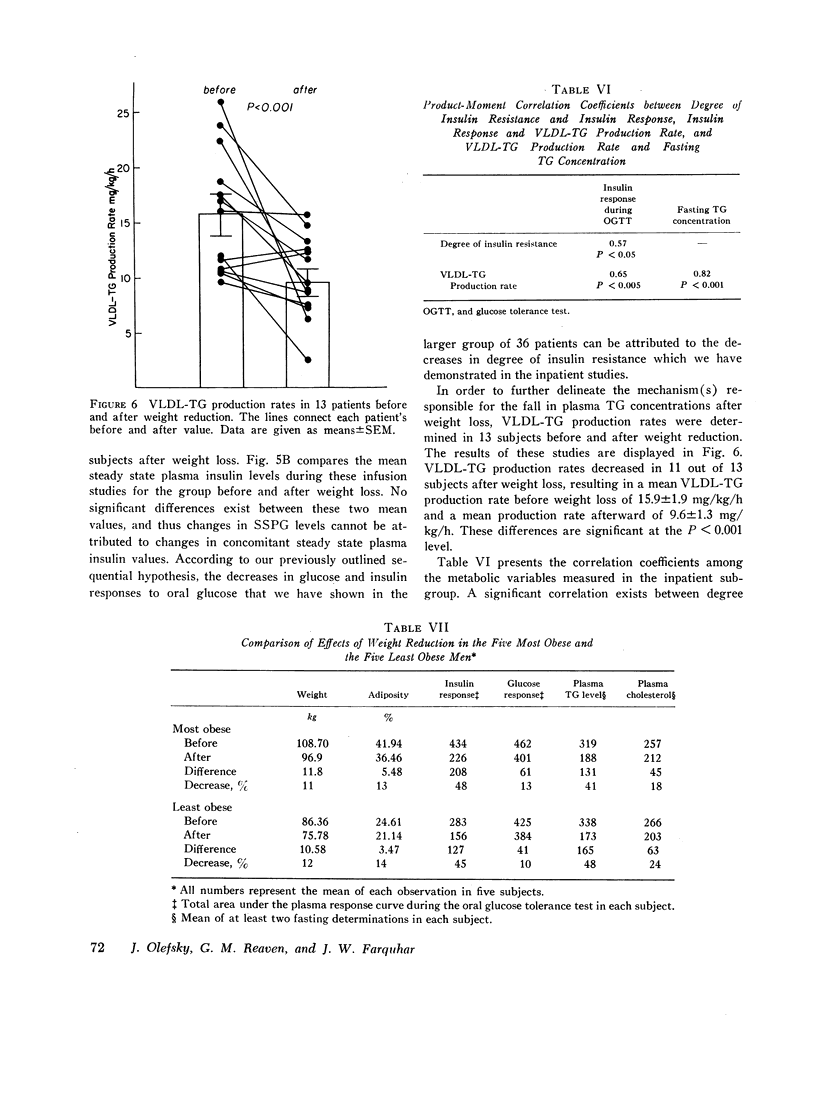
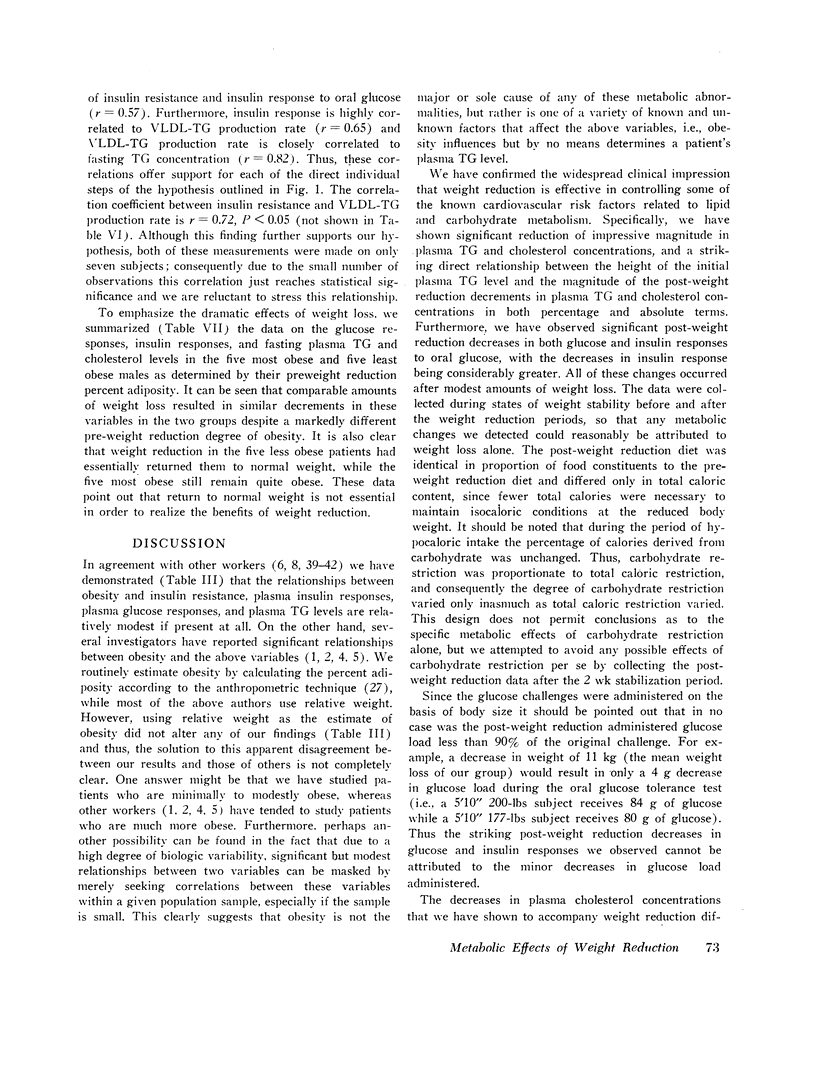
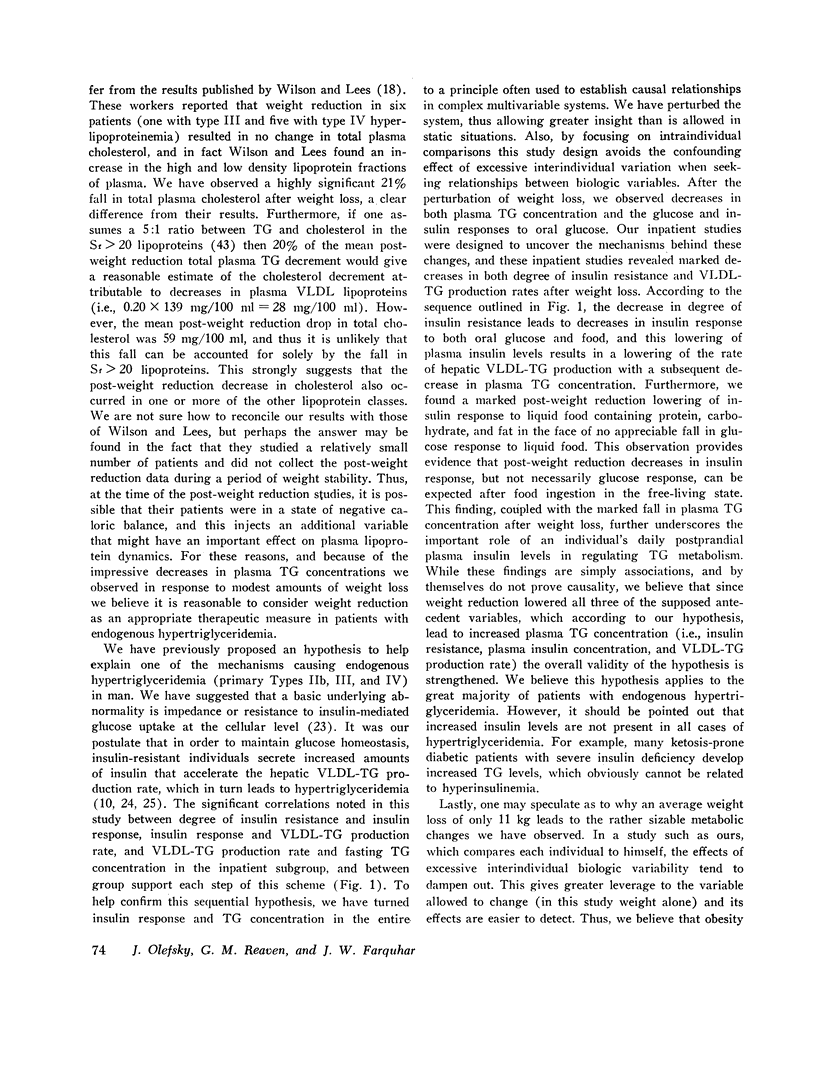
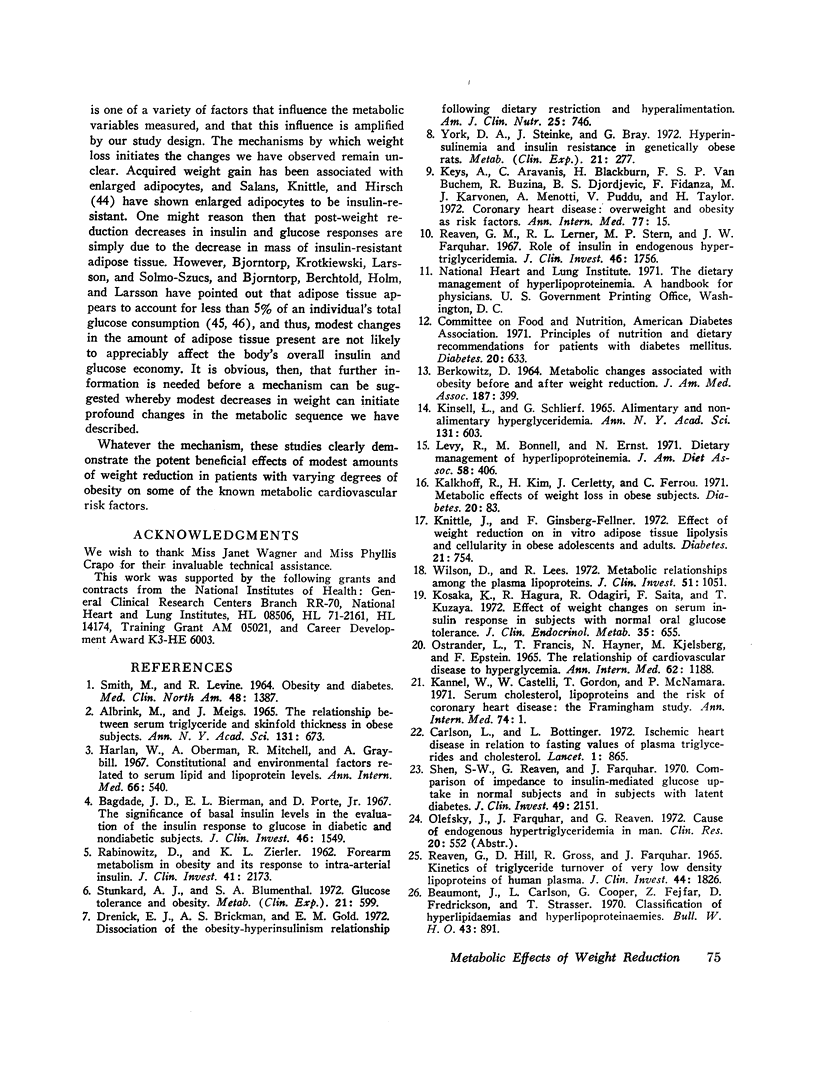
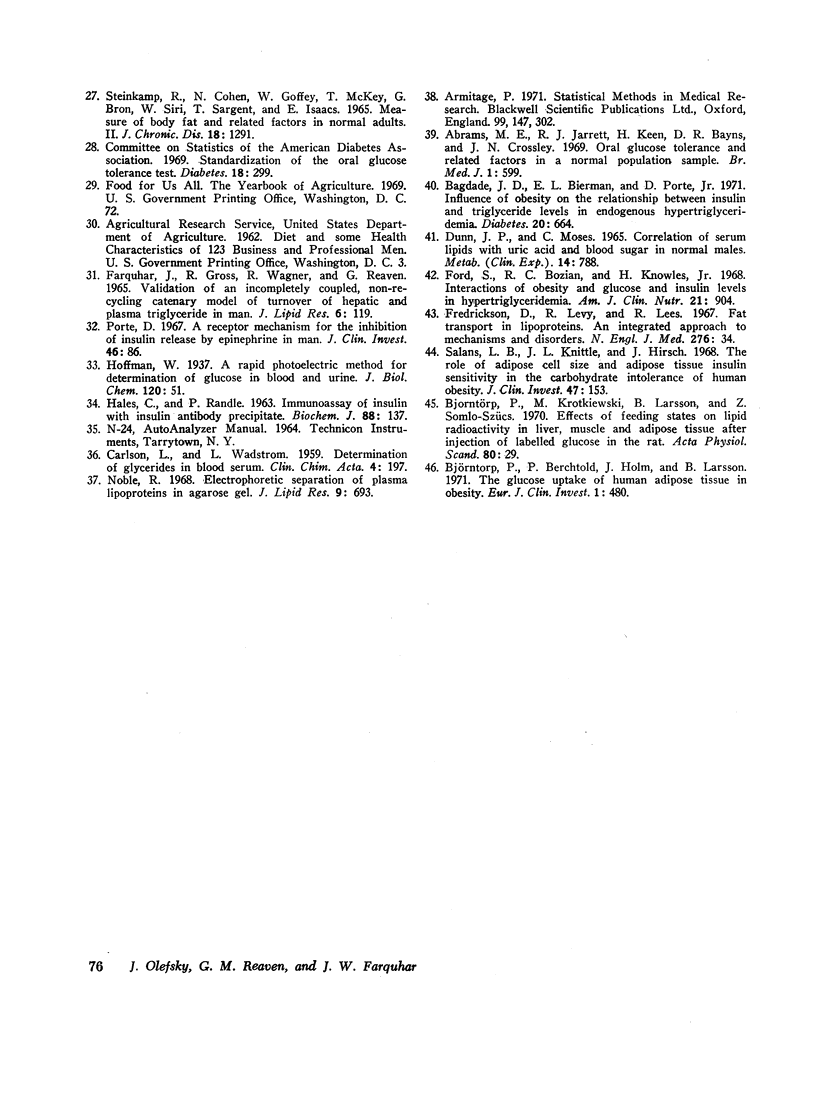
Images in this article
Selected References
These references are in PubMed. This may not be the complete list of references from this article.
- Abrams M. E., Jarrett R. J., Keen H., Boyns D. R., Crossley J. N. Oral glucose tolerance and related factors in a normal population sample. II. Interrelationship of glycerides, cholesterol, and other factors with the glucose and insulin response. Br Med J. 1969 Mar 8;1(5644):599–602. doi: 10.1136/bmj.1.5644.599. [DOI] [PMC free article] [PubMed] [Google Scholar]
- Albrink M. J., Meigs J. W. The relationship between serum triglycerides and skinfold thickness in obese subjects. Ann N Y Acad Sci. 1965 Oct 8;131(1):673–683. doi: 10.1111/j.1749-6632.1965.tb34830.x. [DOI] [PubMed] [Google Scholar]
- BERKOWITZ D. METABOLIC CHANGES ASSOCIATED WITH OBESITY BEFORE AND AFTER WEIGHT REDUCTION. JAMA. 1964 Feb 8;187:399–403. doi: 10.1001/jama.1964.03060190015003. [DOI] [PubMed] [Google Scholar]
- Bagdade J. D., Bierman E. L., Porte D., Jr Influence of obesity on the relationship between insulin and triglyceride levels in endogenous hypertriglyceridemia. Diabetes. 1971 Oct;20(10):664–672. doi: 10.2337/diab.20.10.664. [DOI] [PubMed] [Google Scholar]
- Bagdade J. D., Bierman E. L., Porte D., Jr The significance of basal insulin levels in the evaluation of the insulin response to glucose in diabetic and nondiabetic subjects. J Clin Invest. 1967 Oct;46(10):1549–1557. doi: 10.1172/JCI105646. [DOI] [PMC free article] [PubMed] [Google Scholar]
- Beaumont J. L., Carlson L. A., Cooper G. R., Fejfar Z., Fredrickson D. S., Strasser T. Classification of hyperlipidaemias and hyperlipoproteinaemias. Bull World Health Organ. 1970;43(6):891–915. [PMC free article] [PubMed] [Google Scholar]
- Björntorp P., Berchtold P., Holm J., Larsson B. The glucose uptake of human adipose tissue in obesity. Eur J Clin Invest. 1971 Sep;1(6):480–485. doi: 10.1111/j.1365-2362.1971.tb00559.x. [DOI] [PubMed] [Google Scholar]
- CARLSON L. A., WADSTROM L. B. Determination of glycerides in blood serum. Clin Chim Acta. 1959 Mar;4(2):197–205. doi: 10.1016/0009-8981(59)90130-5. [DOI] [PubMed] [Google Scholar]
- Carlson L. A., Böttiger L. E. Ischaemic heart-disease in relation to fasting values of plasma triglycerides and cholesterol. Stockholm prospective study. Lancet. 1972 Apr 22;1(7756):865–868. doi: 10.1016/s0140-6736(72)90738-6. [DOI] [PubMed] [Google Scholar]
- Drenick E. J., Brickman A. S., Gold E. M. Dissociation of the obesity-hyperinsulinism relationship following dietary restriction and hyperalimentation. Am J Clin Nutr. 1972 Aug;25(8):746–755. doi: 10.1093/ajcn/25.8.746. [DOI] [PubMed] [Google Scholar]
- FARQUHAR J. W., GROSS R. C., WAGNER R. M., REAVEN G. M. VALIDATION OF AN INCOMPLETELY COUPLED TWO-COMPARTMENT NONRECYCLING CATENARY MODEL FOR TURNOVER OF LIVER AND PLASMA TRIGLYCERIDE IN MAN. J Lipid Res. 1965 Jan;6:119–134. [PubMed] [Google Scholar]
- Ford S., Jr, Bozian R. C., Knowles H. C., Jr Interactions of obesity, and glucose and insulin levels in hypertriglyceridemia. Am J Clin Nutr. 1968 Sep;21(9):904–910. doi: 10.1093/ajcn/21.9.904. [DOI] [PubMed] [Google Scholar]
- Fredrickson D. S., Levy R. I., Lees R. S. Fat transport in lipoproteins--an integrated approach to mechanisms and disorders. N Engl J Med. 1967 Jan 5;276(1):34–contd. doi: 10.1056/NEJM196701052760107. [DOI] [PubMed] [Google Scholar]
- HALES C. N., RANDLE P. J. Immunoassay of insulin with insulin-antibody precipitate. Biochem J. 1963 Jul;88:137–146. doi: 10.1042/bj0880137. [DOI] [PMC free article] [PubMed] [Google Scholar]
- Harlan W. R., Jr, Oberman A., Mitchell R. E., Graybiel A. Constitutional and environmental factors related to serum lipid and lipoprotein levels. Ann Intern Med. 1967 Mar;66(3):540–555. doi: 10.7326/0003-4819-66-3-540. [DOI] [PubMed] [Google Scholar]
- Kalkhoff R. K., Kim H. J., Cerletty J., Ferrou C. A. Metabolic effects of weight loss in obese subjects. Changes in plasma substrate levels, insulin and growth hormone responses. Diabetes. 1971 Feb;20(2):83–91. doi: 10.2337/diab.20.2.83. [DOI] [PubMed] [Google Scholar]
- Kannel W. B., Castelli W. P., Gordon T., McNamara P. M. Serum cholesterol, lipoproteins, and the risk of coronary heart disease. The Framingham study. Ann Intern Med. 1971 Jan;74(1):1–12. doi: 10.7326/0003-4819-74-1-1. [DOI] [PubMed] [Google Scholar]
- Keys A., Aravanis C., Blackburn H., Van Buchem F. S., Buzina R., Djordjevic B. S., Fidanza F., Karvonen M. J., Menotti A., Puddu V. Coronary heart disease: overweight and obesity as risk factors. Ann Intern Med. 1972 Jul;77(1):15–27. doi: 10.7326/0003-4819-77-1-15. [DOI] [PubMed] [Google Scholar]
- Kinsell L. W., Schlierf G. Alimentary and nonalimentary hyperglyceridemia. Ann N Y Acad Sci. 1965 Oct 8;131(1):603–613. doi: 10.1111/j.1749-6632.1965.tb34823.x. [DOI] [PubMed] [Google Scholar]
- Knittle J. L., Ginsberg-Fellner F. Effect of weight reduction on in vitro adipose tissue lipolysis and cellularity in obese adolescents and adults. Diabetes. 1972 Jun;21(6):754–761. doi: 10.2337/diab.21.6.754. [DOI] [PubMed] [Google Scholar]
- Kosaka K., Hagura R., Odagiri R., Saito F., Kuzuya T. Effect of weight changes on serum insulin response in subjects with normal oral glucose tolerance. J Clin Endocrinol Metab. 1972 Nov;35(5):655–658. doi: 10.1210/jcem-35-5-655. [DOI] [PubMed] [Google Scholar]
- Levy R. I., Bonnell M., Ernst N. D. Dietary management of hyperlipoproteinemia. J Am Diet Assoc. 1971 May;58(5):406–416. [PubMed] [Google Scholar]
- Noble R. P. Electrophoretic separation of plasma lipoproteins in agarose gel. J Lipid Res. 1968 Nov;9(6):693–700. [PubMed] [Google Scholar]
- OSTRANDER L. D., Jr, FRANCIS T., Jr, HAYNER N. S., KJELSBERG M. O., EPSTEIN F. H. THE RELATIONSHIP OF CARDIOVASCULAR DISEASE TO HYPERGLYCEMIA. Ann Intern Med. 1965 Jun;62:1188–1198. doi: 10.7326/0003-4819-62-6-1188. [DOI] [PubMed] [Google Scholar]
- Porte D., Jr A receptor mechanism for the inhibition of insulin release by epinephrine in man. J Clin Invest. 1967 Jan;46(1):86–94. doi: 10.1172/JCI105514. [DOI] [PMC free article] [PubMed] [Google Scholar]
- RABINOWITZ D., ZIERLER K. L. Forearm metabolism in obesity and its response to intra-arterial insulin. Characterization of insulin resistance and evidence for adaptive hyperinsulinism. J Clin Invest. 1962 Dec;41:2173–2181. doi: 10.1172/JCI104676. [DOI] [PMC free article] [PubMed] [Google Scholar]
- Reaven G. M., Hill D. B., Gross R. C., Farquhar J. W. Kinetics of triglyceride turnover of very low density lipoproteins of human plasma. J Clin Invest. 1965 Nov;44(11):1826–1833. doi: 10.1172/JCI105290. [DOI] [PMC free article] [PubMed] [Google Scholar]
- Reaven G. M., Lerner R. L., Stern M. P., Farquhar J. W. Role of insulin in endogenous hypertriglyceridemia. J Clin Invest. 1967 Nov;46(11):1756–1767. doi: 10.1172/JCI105666. [DOI] [PMC free article] [PubMed] [Google Scholar]
- Salans L. B., Knittle J. L., Hirsch J. The role of adipose cell size and adipose tissue insulin sensitivity in the carbohydrate intolerance of human obesity. J Clin Invest. 1968 Jan;47(1):153–165. doi: 10.1172/JCI105705. [DOI] [PMC free article] [PubMed] [Google Scholar]
- Shen S. W., Reaven G. M., Farquhar J. W. Comparison of impedance to insulin-mediated glucose uptake in normal subjects and in subjects with latent diabetes. J Clin Invest. 1970 Dec;49(12):2151–2160. doi: 10.1172/JCI106433. [DOI] [PMC free article] [PubMed] [Google Scholar]
- Steinkamp R. C., Cohen N. L., Gaffey W. R., McKey T., Bron G., Siri W. E., Sargent T. W., Isaacs E. Measures of body fat and related factors in normal adults. II. A simple clinical method to estimate body fat and lean body mass. J Chronic Dis. 1965 Dec;18(12):1291–1307. doi: 10.1016/0021-9681(65)90162-1. [DOI] [PubMed] [Google Scholar]
- Stunkard A. J., Blumenthal S. A. Glucose tolerance and obesity. Metabolism. 1972 Jul;21(7):599–602. doi: 10.1016/0026-0495(72)90083-2. [DOI] [PubMed] [Google Scholar]
- Wilson D. E., Lees R. S. Metabolic relationships among the plasma lipoproteins. Reciprocal changes in the concentrations of very low and low density lipoproteins in man. J Clin Invest. 1972 May;51(5):1051–1057. doi: 10.1172/JCI106896. [DOI] [PMC free article] [PubMed] [Google Scholar]
- York D. A., Steinke J., Bray G. A. Hyperinsulinemia and insulin resistance in genetically obese rats. Metabolism. 1972 Apr;21(4):277–284. doi: 10.1016/0026-0495(72)90070-4. [DOI] [PubMed] [Google Scholar]



